Fluorescence image screening for chemical compounds modifying cholesterol metabolism and distribution
- PMID: 21862703
- PMCID: PMC3196239
- DOI: 10.1194/jlr.D018184
Fluorescence image screening for chemical compounds modifying cholesterol metabolism and distribution
Abstract
An automated fluorescence microscopy assay using a nontoxic cholesterol binding protein, toxin domain 4, (D4), was developed in order to identify chemical compounds modifying intracellular cholesterol metabolism and distribution. Using this method, we screened a library of 1,056 compounds and identified 35 compounds that decreased D4 binding to the cell surface. Among them, 8 compounds were already reported to alter the biosynthesis or the intracellular distribution of cholesterol. The remaining 27 hit compounds were further analyzed biochemically and histochemically. Cell staining with another fluorescent cholesterol probe, filipin, revealed that 17 compounds accumulated cholesterol in the late endosomes. Five compounds decreased cholesterol biosynthesis, and two compounds inhibited the binding of D4 to the membrane. This visual screening method, based on the cholesterol-specific probe D4 in combination with biochemical analyses, is a cell-based, sensitive technique for identifying new chemical compounds and modifying cholesterol distribution and metabolism. Furthermore, it is suitable for high-throughput analysis for drug discovery.
Figures
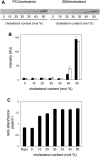
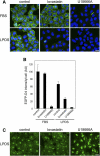
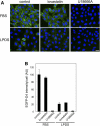
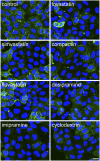

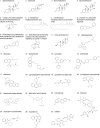

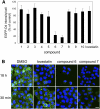
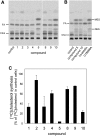
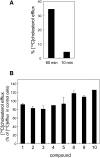
Similar articles
-
Automated microscopy screening for compounds that partially revert cholesterol accumulation in Niemann-Pick C cells.J Lipid Res. 2006 Feb;47(2):284-301. doi: 10.1194/jlr.M500388-JLR200. Epub 2005 Nov 15. J Lipid Res. 2006. PMID: 16288097
-
Methods for Visualizing and Quantifying Cholesterol Distribution in Mammalian Cells Using Filipin and D4 Probes.Methods Mol Biol. 2025;2888:101-118. doi: 10.1007/978-1-0716-4318-1_8. Methods Mol Biol. 2025. PMID: 39699727
-
Biotinylated theta-toxin derivative as a probe to examine intracellular cholesterol-rich domains in normal and Niemann-Pick type C1 cells.J Lipid Res. 2003 May;44(5):1033-41. doi: 10.1194/jlr.D200036-JLR200. Epub 2003 Feb 1. J Lipid Res. 2003. PMID: 12562855
-
Intracellular cholesterol trafficking: role of the NPC1 protein.Biochim Biophys Acta. 2000 Jun 26;1486(1):171-83. doi: 10.1016/s1388-1981(00)00055-x. Biochim Biophys Acta. 2000. PMID: 10856720 Review. No abstract available.
-
Niemann-Pick type C mutations cause lipid traffic jam.Traffic. 2000 Mar;1(3):218-25. doi: 10.1034/j.1600-0854.2000.010304.x. Traffic. 2000. PMID: 11208105 Review.
Cited by
-
Fluorescent Sterols and Cholesteryl Esters as Probes for Intracellular Cholesterol Transport.Lipid Insights. 2016 Jun 9;8(Suppl 1):95-114. doi: 10.4137/LPI.S31617. eCollection 2015. Lipid Insights. 2016. PMID: 27330304 Free PMC article. Review.
-
A basic model for the association of ligands with membrane cholesterol: application to cytolysin binding.J Lipid Res. 2023 Apr;64(4):100344. doi: 10.1016/j.jlr.2023.100344. Epub 2023 Feb 13. J Lipid Res. 2023. PMID: 36791915 Free PMC article.
-
Fatty acid-binding proteins 3, 7, and 8 bind cholesterol and facilitate its egress from lysosomes.J Cell Biol. 2024 Apr 1;223(4):e202211062. doi: 10.1083/jcb.202211062. Epub 2024 Mar 1. J Cell Biol. 2024. PMID: 38429999 Free PMC article.
-
Plasma membrane phosphatidylinositol (4,5)-bisphosphate is critical for determination of epithelial characteristics.Nat Commun. 2022 May 9;13(1):2347. doi: 10.1038/s41467-022-30061-9. Nat Commun. 2022. PMID: 35534464 Free PMC article.
-
Plasma Membrane Origin of the Steroidogenic Pool of Cholesterol Used in Hormone-induced Acute Steroid Formation in Leydig Cells.J Biol Chem. 2016 Dec 9;291(50):26109-26125. doi: 10.1074/jbc.M116.740928. Epub 2016 Nov 3. J Biol Chem. 2016. PMID: 27815506 Free PMC article.
References
-
- Simons K., Vaz W. L. 2004. Model systems, lipid rafts, and cell membranes. Annu. Rev. Biophys. Biomol. Struct. 33: 269–295 - PubMed
-
- Epand R. M., Thomas A., Brasseur R., Epand R. F. 2010. Cholesterol interaction with proteins that partition into membrane domains: an overview. Subcell. Biochem. 51: 253–278 - PubMed
-
- Simons K., Toomre D. 2000. Lipid rafts and signal transduction. Nat. Rev. Mol. Cell Biol. 1: 31–39 - PubMed
-
- Goldstein J. L., DeBose-Boyd R. A., Brown M. S. 2006. Protein sensors for membrane sterols. Cell. 124: 35–46 - PubMed
-
- Ikonen E. 2008. Cellular cholesterol trafficking and compartmentalization. Nat. Rev. Mol. Cell Biol. 9: 125–138 - PubMed
Publication types
MeSH terms
Substances
LinkOut - more resources
Full Text Sources
Medical

